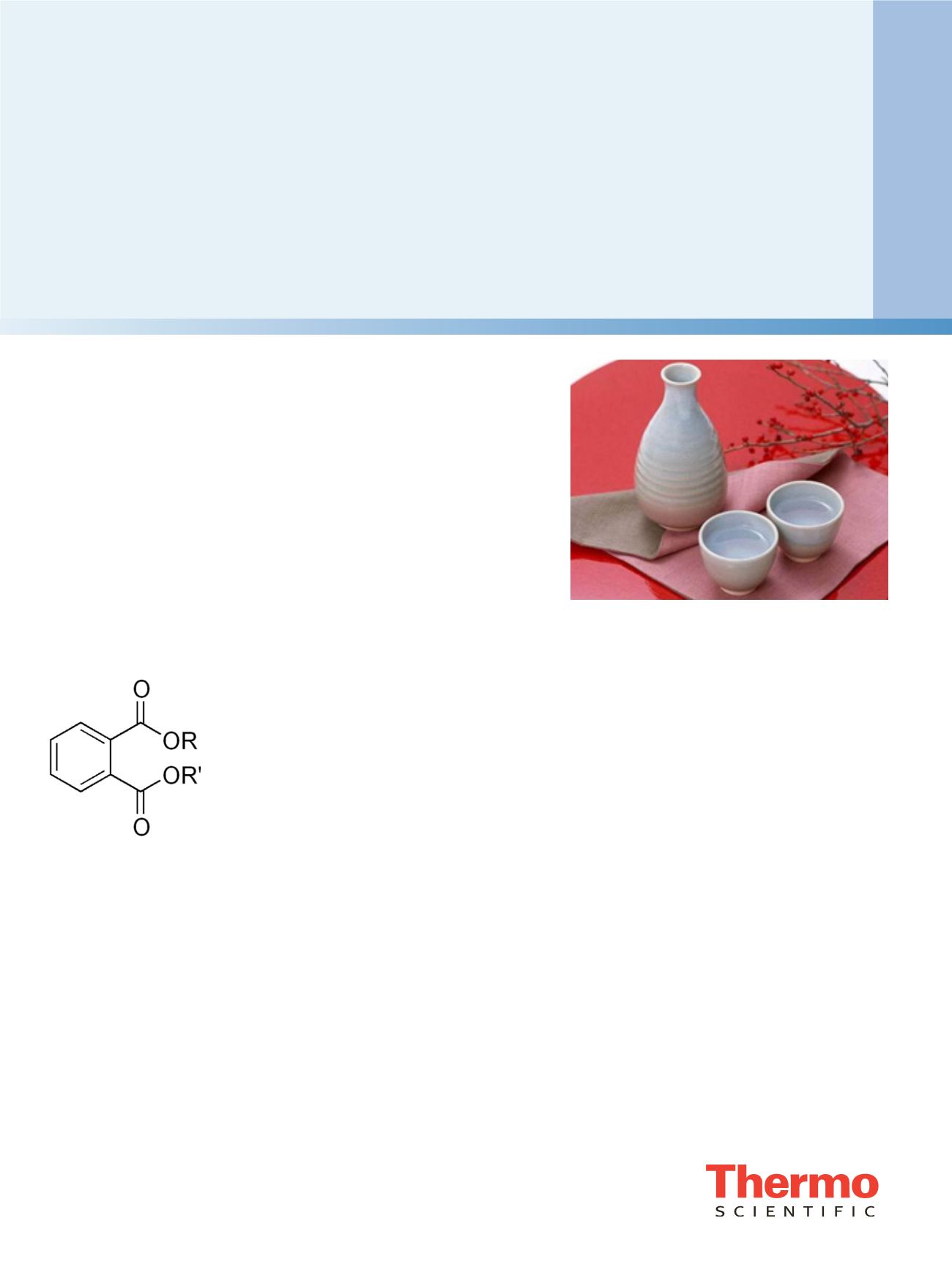
Technical Support Note-000
Determination of Phthalates in Liquor
Beverages by Single Quadrupole GC-MS
Jianxia Lv
1
, Lina Liang
1
, Hans-Joachim Huebschmann
2
Thermo Fisher Scientific,
1
Beijing, China,
2
Singapore
centrifuge tube and then heated in a boiling water bath
to remove the ethanol
2
. The heating time depends on
the alcoholic strength of the spirit sample. Usually the
tube was removed from the water bath with a residual
volume of 2-3 mL. After cooling to room temperature,
2.0 mL of n-hexane was added, and the glass tube was
shaken for extraction and left standing 5 minutes for
phase separation. The supernatant was transferred
to autosampler vials for analysis. Special attention is
required that all glassware need to be cleaned with
hexane and baked in a muffle furnace at about 450 °C in
order to avoid contamination.
A commercial phthalate standard was used for method
development. For optimization of the extraction
procedure and recovery determination, one liquor sample
was spiked with 4 mg/L concentration of the phthalate
standard.
GC-MS instrument conditions
All measurements have been carried out using the Thermo
Scientific™ ISQ Series single quadrupole GC-MS system
with a Thermo Scientific™ TRACE™ 1310 GC equipped
with the instant connect SSL injector module (split/
splitless injector) and a Thermo Scientific AS 1310 liquid
autosampler. The instrument conditions are listed in
Tables 1 and 2.
Introduction
Phthalates (Phthalate Acid Esters, PAEs) have widespread use in the polymer
industry as plasticizers and softeners to increase the plasticity of polymer
materials and their toughness and strength. They are chemically inert, have
high density, low to medium volatility, high solubility in organic solvents,
and are easily released to the environment during aging of polymer materials.
Phthalates had been reported as functional solvents in the aromatic, essential
oil, and even beverage industries. Phthalate plasticizers also migrate from
plastic containers or closures into soft drinks and alcoholic beverages.
PAEs in the environment and food chain can act as hormones, simulate
the body
’
s natural endocrine responses, interfere with the normal role of
hormones, and affect the body’s most basic physiological control mechanisms.
Phthalates are reported to cause carcinogenic, teratogenic, and mutagenic
effects and constitute a health hazard to humans.
Phthalate residues in food and beverages are
regulated internationally. The China Ministry
of Health issued a public notice on June
1
st
, 2011, that phthalate esters are clearly
prohibited as non-food substances for use in
food. PAEs are introduced into the food chain
primarily through food packaging material.
Alcoholic beverages in plastic containers are
a particular risk, since the containing ethanol
provides a very good solubility for PAEs and
is leaching the PAEs into the beverages from
the plastic contact materials. The contamination risk increases with liquors
having high ethanol content. On November 19
th
, 2012, Chinese media reported
that, according to third-party testing, PAE plasticizer content in a well-known
domestic liquor brand was up to 260% higher than the regulated level.
This study follows the China regulation GB/T 21911-2008 for the determining
of phthalates in food
1
.The sample preparation procedure was optimized from
GB/T 21911-2008 with the ethanol removal from liquor beverages followed
by an n-hexane extraction and gas chromatography/mass spectrometry (GC-
MS) detection. The method is sensitive, rapid, and accurate, and covers a wide
linear range to meet the need for trace level detection of phthalate esters in
different types of beverages.
Experimental Conditions
Sample preparation
The sample used for this application was a white spirit, bought from a local
liquor store. An accurate amount of 5.0 mL sample was transferred in a glass
Application No e 10339


